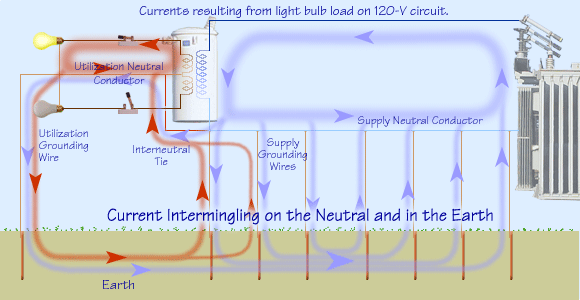Intermingling
|
|
|
|
In Section 2a [Power Systems], we learned that
the supply-side and the utilization-side neutral conductors are connected for safety reasons.
The tie wire between the neutrals (across the transformer) allows the currents from each side
to cross over to the other and intermingle on the neutral wires and in the earth. Some current
from the supply side flows on the conductive pathways of the utilization side and vice versa.
This cross-flow is illustrated below for the single light bulb case.
|
|
|









|
 
|
|
As a result of this cross-flow, the neutral and grounding conductors on the supply side carry
some of the utilization return current, and the utilization-side neutral and grounding
conductors carry some of the supply-side return current.
This is a normal and natural consequence of operating safely grounded electrical systems. |
|
These additional currents will add to or subtract from the basic currents
depending on the direction of current flow and other characteristics of the current
signals themselves (e.g. phasing). Notice in the illustration above that the
currents add up on the interneutral connection, on the
utilization-side grounding wires, and in the earth,
while they partially cancel one another out on the utilization-side neutral
conductor and on the supply-side grounding wires. |
|
The strength of the voltage gradient formed by current flowing in the earth at each
electrode is affected
by changes in the amount of current flowing through that electrode.
We have seen that the shape of the gradient for each electrode does not
change with the current level because it is a characteristic of the electrode
itself. However, when gradients from different electrodes combine, the strength of
the gradient caused by each electrode does make a difference in the resulting gradient shape.
The final pattern of the combined gradients is dynamic; it changes as the net current
in the various electrodes changes due to variations in electrical load and these
intermingling components. |
 
|
|
The combined gradient pattern is similar to that of sprinklers arranged in a field.
Each sprinkler
has its own sprinkling pattern, either circular or fan-like. The reach of each
sprinkler depends on water flow and pressure. The final watering pattern
depends on the arrangement of the sprinklers and the water flow.
Once the sprinklers are fixed in the earth, the only way to change the watering
pattern is to change the water flow in each of them. |
|
|
|
|
|
|





|
